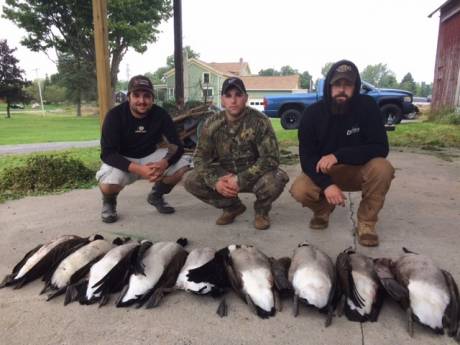Sponsored Post: Bontrager hosts hunting and sportsman's equipment auction. Bid online now

Click here to view items and bid!

Click here to view items and bid!

Definitely worth coming and letting your imagination run with all that you could do with this home-great way and time to jump into home ownership! Click here for more information or call Lynn Bezon today at Reliant Real Estate today, call (585) 344-HOME (4663).
1595 Bank Street Road, Middlebury -- Calling all hunters, wildlife lovers, or anyone looking for solitude and nature! This property has a little bit of something for everyone -- two-bedroom fully remodeled 1985 mobile home, move in ready and situated on over 7 acres with a 36x40 barn, two ponds and some great woods! Home has all new windows, 3 yr old metal roof, newly remodeled kitchen and bath, super cozy wood burning stove and appliances included! 200 amp electric and 4 yr new septic an added plus.
Sliding-glass doors leads to covered back patio area and great views:) Great woods and could be logged for extra ready income! The barn is ready for all your toys or shop needs -- water ready, plumbed for bath, cement floors and 100 amp electrical service. Also for all those with technology needs there is high speed cable available as well! Definitely come ready to take a walk and discover everything this property has to offer! Click here for more information or call Lynn Bezon today at Reliant Real Estate today, call (585) 344-HOME (4663).

Reliant Real Estate - New listing Alert! 1595 Bank Street Road, Middlebury! Calling all hunters, wildlife lovers, or anyone looking for solitude and nature!
This property has a little bit of something for everyone -- two bedroom, fully remodeled, 1985 mobile home. Move-in ready and situated on over 7 acres with a 36x40 barn, two ponds and some great woods!
Home has all new windows, 3-year-old metal roof, newly remodeled kitchen and bath, super cozy wood burning stove and appliances included! 200 amp electric and 4-year-new septic an added plus. Sliding glass doors lead to covered back patio area and great views.
Great woods and could be logged for extra ready income! The barn is ready for all your toys or shop needs -- water ready, plumbed for bath, cement floors and 100-amp electrical service. Also for all those with technology needs there is high speed cable available as well!
Definitely come ready to take a walk and discover everything this property has to offer! Call Lynn Bezon at Reliant Real Estate today, call 344-HOME (4663). Click here for more info.
Press release:
Iroquois National Wildlife Refuge (NWR) announces online permits for the youth waterfowl hunt and COVID-19 waterfowl blind draw procedures. Additionally, the Refuge announces the 2020 Final Hunting Plan for Iroquois NWR has been approved and awaits publication in the Federal Register.
The Iroquois NWR Youth Waterfowl Hunt remains the same except permitting will now be done online. Permits are available first-come, first-serve from Aug. 15 until Sept. 15. The permit is free, but space is limited to 15 participants this year.
You will receive your permit letter and Parental Consent Form upon checking out on RecAccess.
The preseason waterfowl lottery draws will once again be on RecAccess. However, morning blind draws for the entire regular season will now be held at the Refuge Shop at 1101 Casey Road in Basom to ensure the safety of staff and the public during the COVID-19 pandemic.
Details of how we will safely proceed will be disseminated through our website, Facebook, and RecAccess as opening day approaches.
The 2020 Final Hunting Plan has been approved and posted on our website. This plan includes changes to the 2020-2021 hunt seasons on Iroquois NWR, including other migratory birds, small game, fall turkey, and the second session of the waterfowl season.
Once these changes are published in the Federal Register, we will be able to implement them. This will be reflected on our website and fact sheets as appropriate. Please continue to check our website periodically for updates.
For further information please see our website or email Iroquois National Wildlife Refuge or phone Visitor Services specialist Eric Schaertl at (585) 948-5445, ext. 7036. Iroquois NWR is located midway between Buffalo and Rochester and is managed by the U.S. Fish and Wildlife Service.
Press release:
Iroquois National Wildlife Refuge (INWR) announces changes to the turkey hunt and youth turkey hunt application processes for the 2020 season.
In order to streamline these processes, applications are now done online here. You can create an account, or log into your existing account at the website. Once you are logged in, select the appropriate hunt, and follow the prompts to apply.
Applications can be filled out online from March 1 until April 1 for both hunts.
The youth turkey applications will be on a first-come, first-serve basis. There is no fee for this permit.
The preseason lottery will be conducted to select hunters for the first and second sessions of the spring turkey hunt season. Please note there will be a $5 application fee to cover administrative costs.
Winners will be notified approximately one week after the close of the application period by email, whether selected or not.
All other aspects of the Iroquois NWR turkey hunt will be similar to previous years.
Hunters with disabilities may contact the refuge for information on how to apply.
Please see the Turkey Hunting and Youth Turkey Hunt Fact Sheets for full details on the 2020 hunting season, which can be found on the Permits page of the INWR website.
INWR is located midway between Buffalo and Rochester, and is managed by the U.S. Fish and Wildlife Service. For further information contact Iroquois National Wildlife Refuge, 1101 Casey Road, Basom, NY 14013, or call 585-948-5445.
Press release from Senator Michael Ranzenhofer:
Participation in hunting is declining across New York State and much of the nation.
This not only has a dramatic impact on conservation funding but also a negative impact on state revenues. It is important that the state examine ways to both attract and retain hunters.
Expanding opportunities for hunters can help boost state revenue and aid the environment.
The issue of hunters “aging out” is well documented and it is important for New York State to do all it can to reverse this trend.
Expanding crossbow-hunting opportunities and loosening ambulatory hunting requirements would provide thousands of willing hunters the opportunity to continue pursuing their passion.
Current laws regarding ambulatory licenses, require that license holders need permanent assistance to qualify.
That being said, many hunters do not need assistance devices to complete daily activities but are unable to navigate a field or more rugged terrain without assistance.
This reality should be reflected when determining who qualifies for these privileges. If enacted, these proposals would help countless hunters.
In addition to retaining hunters, attracting new hunters is critical.
Lowering the hunting age has long been discussed as the primary way to get youth more engaged at a younger age.
While I do believe that reducing the big game hunting age to 12 would be helpful, hunter apprentice programs should also be examined.
Hunter apprentice programs have proven to be an extremely safe and effective way to introduce more youths to hunting in other states.
With the state facing a $6.1 billion deficit, I believe there is a tremendous opportunity to advance proposals that are positive for hunters as well as generate much needed license revenue and conservation dollars for the state.
I have shared these opinions with the Governor and colleagues in the legislature and will continue to advocate for their adoption.
Supporting hunting helps the environment, supports rural communities and provides license revenue for New York State.

Press release:
Iroquois National Wildlife Refuge (NWR) announces changes to the waterfowl hunt lottery application process for the 2019/2020 season. The preseason lottery will be conducted to select hunters for the first two Saturdays of the hunt season.
In order to streamline the lottery process, applications are now done online here. Follow the prompts to apply. Please note there will be a $5 application fee to cover administrative costs.
Applications can be filled out online from Aug. 15 until Sept. 15.
Winners will be notified approximately one week after the close of the application period by email if selected.
A copy of the lottery win receipt must accompany the hunter to the check station the morning of their hunt.
Please see our Waterfowl Hunting Fact Sheet for full details on the 2019/2020 waterfowl hunting season, which can be found here.
All other aspects of the Iroquois NWR waterfowl hunt will be similar as in previous years, including hunter standby, blind drawings, and non-lottery hunt days.
Youth waterfowl hunters and hunters with disabilities will apply using the same methods as in previous years. Click here for full details.
For further information contact Iroquois National Wildlife Refuge, 1101 Casey Road, Basom, NY 14013, or call 585-948-5445.
Iroquois NWR is located midway between Buffalo and Rochester and is managed by the U.S. Fish and Wildlife Service.
Jim Beverly, a hunting retriever trainer from Oakfield, hosted his second annual Companion Retriever Hunting Challenge at Godfrey's Pond in Byron on Saturday. The challenge is primarily for retrieving-trained dogs who are more often pets than hunting companions.
The 72nd annual Batavia Gun and Sportsman Show will be held the weekend of March 16-17 at Quality Inn & Suites in Batavia.
Times are 9 a.m. to 4 p.m. on Saturday, and 9 a.m. to 3 p.m. on Sunday. The hotel is located at 8250 Park Road.
Admission is $5; children age 12 and under get in free when accompanied by adult.
More than 130 8-foot vendor and exhibitor tables will be chock full of items and there's plenty of free parking.
This event is sponsored by the Alabama Hunt Club, located on Lewiston Road in Alabama.
The show will feature collector, antique and investment firearms, swords and knives, Revolutionary War to World War II militaria, books, traps, pistols, gun parts, ammo and hunting accessories, black powder accessories, reloading equipment, archery, medals and more!
NOTE: All firearm laws MUST be obeyed.
Public participation is encouraged: bring items to sell or trade with dealers.
A National Instant Criminal Background Check MUST be completed prior to all firearm sales. The background check is free.
For more information, contact Dennis Davis at: dwdavis70@gmail.com or phone (585) 798-6089.
Hunting & Fishing Days at Godfrey's Pond!
Join us this weekend for our annual Hunting and Fishing Days!
Saturday & Sunday 10am-4pm.
Vendors Available - with music both days!
Come and try us out!
Click here to visit us online
Hunting & Fishing Days at Godfrey's Pond!
Join us this weekend for our annual Hunting and Fishing Days!
Saturday & Sunday 10am-4pm.
Vendors Available - with music both days!
Come and try us out!
Click here to visit us online
Press release:
The New York State Department of Environmental Conservation (DEC) announced today that the 2017-18 Western New York trapping season for fox, raccoon, coyote and other upland furbearing animals opens on Oct. 25 and closes on Feb. 15.
The start of upland trapping will be delayed until Nov. 1 at the John White Wildlife Management Area (WMA), and the trapping season for mink, muskrat and beaver at this WMA will run from Nov. 25 until Feb. 15.
The start of muskrat and mink trapping at the Oak Orchard and Tonawanda WMAs will run from Dec. 2 to Feb. 15.
Beginning Oct. 2, trapping permits will be issued for the Oak Orchard, Tonawanda, and John White WMAs for the 2017-2018 license year.
Permit applications can be obtained weekdays from Oct. 2 to Nov. 30, by appearing in person at the Iroquois National Wildlife Refuge Office on Casey Road between 8 a.m. and 4 p.m., or by writing to the DEC, Bureau of Wildlife, 1101 Casey Road, Box B, Basom, NY 14013.
Trappers who obtain a permit will be required to report their harvest and trapping efforts on each area.
After last year’s extreme drought, water levels on these areas are back to normal conditions this year, but there are new areas of dense vegetation in several marshes. Wetland muskrat and mink trapping maybe limited to dike trapping in a number of marshes to allow the muskrat population to continue to recover from the drought, especially in marshes where increased muskrat numbers will benefit marsh habitat conditions. Full access for trapping will be permitted in the remaining marshes.
Additional information will be available by Oct. 2, and when trapping permits are issued.
The maximum number of traps a trapper can set for muskrat and mink in water on the three areas is 25. To accomplish this, DEC issues 25 numbered tags to each trapper that obtains a permit. A tag must be attached to each trap used on the areas. Any trap that does not have one of these tags attached is an illegal trap.
In addition, an individual trapper can only operate traps that contain tags with their assigned numbers. Traps set for upland trapping and beaver will not require numbered tags and will not be considered in the trap limit. The trap limit provides a more equitable distribution of the harvest and prevents trappers from monopolizing the better trapping areas.
Management of the muskrat population promotes prime emergent marsh habitats used by waterfowl and uncommon marsh birds such as the black tern and least bittern. The trap limit and possible additional trapping restrictions allow DEC’s Bureau of Wildlife personnel to better regulate the muskrat harvest according to water availability, habitat needs and population.
DEC reminds hunters and trappers that gas and electric motorboats are prohibited on Oak Orchard or Tonawanda WMAs.
Press release:
New York State Department of Environmental Conservation Commissioner Basil Seggos recently announced the release of a draft New York State Interagency CWD Risk Minimization Plan for public comment.
The plan describes proposed regulatory changes and actions that DEC will take to minimize the risk of Chronic Wasting Disease (CWD) entering or spreading in New York. It was designed to protect both wild white-tailed deer and moose, as well as captive cervids including deer and elk held at enclosed facilities.
DEC biologists worked with the State’s Department of Agriculture and Markets veterinarians and wildlife health experts at Cornell University to craft a comprehensive set of steps that are the most advanced CWD prevention strategies in the nation.
"New York is leading the way in protecting our valuable deer and moose herds," Seggos said. "Not only does this horrible disease kill animals slowly, but wild white-tailed deer hunting represents a $1.5 billion industry in the state.
"Our CWD Risk Minimization Plan is in the best interest of all of us who care about wildlife and especially about the health of our wild white-tail deer herd. Gov. (Andrew) Cuomo's commitment to high-quality hunting opportunities in New York also supports our taking action now to prevent a serious problem down the road."
Disease prevention is the only cost-effective way to keep CWD out of New York. Together with the State Department of Agriculture and Markets, New York is using cutting-edge science and common sense to ensure that everything possible is done to protect the state's herds from CWD.
"The Department's veterinarians and licensed veterinary technicians were responsible for the early detection of New York's only CWD incident and played critical roles in the response to the discovery of CWD in 2005,” said State Agriculture Commissioner Richard A. Ball.
“Our staff continue to work hard to control the risk of this serious disease and maintain our early detection system. This plan will further support these efforts to protect our wildlife."
CWD, an always fatal brain disease found in species of the deer family, was discovered in Oneida County’s wild and captive white-tailed deer in 2005. More than 47,000 deer have been tested statewide since 2002, and there has been no reoccurrence of the disease since 2005. New York is the only state to have eliminated CWD once it was found in wild populations. In North America, CWD has been found in 24 states, including neighboring Pennsylvania and Ohio, and two Canadian provinces.
CWD was first identified in Colorado in 1967 and is caused by infectious prions, which are misfolded proteins that cannot be broken down by the body's normal processes. They cause holes to form in the brain. Prions are found in deer parts and products including urine and feces; they can remain infectious in soil for years and even be taken up into plant tissues. It is in the same family of diseases, transmissible spongiform encephalopathies, as "mad cow" disease in cattle.
Millions of cattle were destroyed because of mad cow disease in England and Europe in the 1990s and the disease also caused a fatal brain condition in some humans that ate contaminated beef products. Although there have been no known cases of CWD in humans, the Centers for Disease Control recommends that no one knowingly eat CWD-positive venison.
The proposed plan would streamline operations between DEC and the State Department of Agriculture and strengthen the state's regulations to prevent introduction of CWD.
Some examples of the proposed changes include:
• Prohibit the importation of certain parts from any CWD-susceptible cervid taken outside of New York. Require that these animals be deboned or quartered and only the meat, raw hide or cape, and cleaned body parts, such as skull cap, antlers, jaws, and teeth, or finished taxidermy mounts be allowed for import into the state;
• Prohibit the retail sale, possession, use, and distribution of deer or elk urine and any products from CWD-susceptible animals that may contain prions, including glands, or other excreted material while allowing New York captive cervid facilities to continue to export deer urine outside of the State;
• Maintain and reinforce the prohibition on the feeding of wild deer and moose in New York State;
• Provide DEC Division of Law Enforcement the necessary authority to enforce Department of Agriculture and Market's CWD regulations;
• Explore possible penalties or charges to defray costs associated with the removal of escaped cervids from the environment or the response to disease outbreaks;
• Require all taxidermists and deer processors (people who butcher deer for hire) to dispose of cervid waste and waste byproducts in compliance with 6 NYCRR Part 360, such as in a municipal landfill;
• Promotion of improved fencing methods for captive cervids to further prevent contact with wild deer or moose;
• Partner with the State Department of Agriculture and Markets to enhance captive cervid testing while continuing DEC's rigorous surveillance testing in hunter-harvested deer;
• Improve record keeping and data sharing between departments through joint inspections of captive cervid facilities, electronic reporting, and animal marking;
• Improve handling requirements, record keeping, and disease testing of wild white-tailed deer temporarily held in captivity for wildlife rehabilitation; and
• Develop a communication plan and strategy to re-engage stakeholders, including captive cervid owners and the public, in CWD risk minimization measures and updates on CWD research.
The New York State Interagency CWD Risk Minimization Plan has had extensive outreach and vetting by sporting groups in the state to address the concerns of myriad stakeholders while maintaining the strength of purpose to protect the public and the environment. The plan updates reporting requirements, improves communication to stakeholders, and simplifies regulations to reduce confusion while protecting our natural resources.
The draft plan is available for public review on the DEC website.
Written comments on the draft plan will be accepted through Sept. 1. Comments can be submitted via email at wildlife@dec.ny.gov, subject: CWD Plan or by writing to NYSDEC, Bureau of Wildlife, 625 Broadway, Albany 12233-4754.
Press release:
Assemblyman Steve Hawley (R,C,I-Batavia) is pleased to announce passage of a bill which will authorize Orleans County and Genesee County residents to hunt big game from Nov. 15 till Dec. 7. The bill allows residents to hunt using pistols, shotguns, muzzle-loaded firearms, long bows, crossbows or rifles.
“Hunting is an important part of our history, it is how our forefathers survived and provided for their families,” Hawley said. “As a strong supporter of the Second Amendment, I am proud to announce that citizens of Orleans and Genesee counties will be able to continue this centuries-old tradition that is such a huge part of our Western New York culture.
"As a proud outdoorsman myself, I will continue to work tirelessly to protect our constitutional rights from special interests attempting to restrict them. The passage of this bill is a step in the right direction toward maintaining our freedom and right to own firearms.”
Press release:
A bill (S5064) continuing the use of rifles for big game hunting in Genesee County indefinitely has passed the State Senate. Senator Michael H. Ranzenhofer is the author and sponsor of the measure in the State Senate.
“Use of rifles for big game hunting has proven to be successful throughout the last two years,” Ranzenhofer said. “Many other rural communities across the state have a permanent provision, and this legislation would set it in stone for Genesee County.”
In 2015, Senator Ranzenhofer spearheaded the effort at the State Capitol to pass a new law (Chapter 68 of the Laws of 2015) that initially allowed the use of rifles in Genesee County. The law expires Oct. 1st of this year. The Genesee County Legislature has requested that the current expiration date be removed.
“Expanding opportunities for sportsmen is important to me. Without legislative action, Genesee County residents would no longer be able to hunt big game with a rifle. I am proud to get the bill approved in the State Senate, and I am hopeful that the State Assembly will follow suit,” Ranzenhofer said.
The bill is currently on the Assembly Agenda. If enacted, the bill would take effect immediately.
In the Fall of 2014, the Genesee County Legislature and Genesee County Federation of Sportsmen's Clubs requested the inaugural legislation. Prior to the enactment of the revised statute, environmental conservation law only authorized the use of pistols, shotguns, crossbows, muzzle-loading firearms or long bows when hunting deer from the first Saturday after Nov. 15 through the first Sunday after Dec. 7.
Press release:
Iroquois National Wildlife Refuge in Genesee and Orleans counties is accepting applications for spring turkey hunting.
The refuge uses a random drawing to fill the 75 turkey hunting permits available; these permits are distributed within two sessions. Session 1 runs from May 1 through May 15 and 50 permits will be issued for this session. Session 2 runs from May 16 through May 31 and 25 permits will be issued for this session.
When applying, hunters should indicate their first and second session preferences. To be entered in the drawing, interested hunters must obtain a Big/Upland Game Hunt Application form (Form 3-2356). Applications can be requested in person, by phone, mail, or email at iroquois@fws.gov. A PDF version of the application form may also be printed from our website http://www.fws.gov/refuge/iroquois. Click on the heading "Visit" and the link "Visitor Activities."
Applications, along with a $5 nonrefundable processing fee, must be received by 4 p.m., March 31. Please refer to our Turkey Hunting Fact Sheet, available at the refuge office or on our website, for additional information.
Please contact refuge staff at 585-948-5445, ext. 7036, for further information.
Iroquois NWR is located midway between Buffalo and Rochester, and is managed by the U.S. Fish & Wildlife Service.
Individuals with disabilities and any other person who may need special assistance to participate in this program should contact the Refuge at 585/948-5445 or at the Federal Relay No. 1-800-877-8339.

Photo and story by Alex Feig, with our news partner, WBTA.
Operation Injured Soldiers was hosting military veterans for the beginning of geese-hunting season at the Wounded Warrior House in Orleans County from Wednesday through Sunday this week.
OIS as it’s called by volunteers, began its presence in the Batavia area around six years ago when veteran Edward Spence got together with several other vets in the area, one of which was Floyd “Skip” Hulburt.
“Ed Spence and I and a fellow veteran, we had talked about establishing OIS in New York, and once it was established Ed Spence just took off with it.”
Skip had just gotten back from another successful hunt but his focus was on a fellow soldier, “My main focus was Jack who is a Vietnam veteran. This is his first time waterfowl hunting so I wanted to get him into it and see how he likes it, and that's a lot of why I do this. I'm not as bad (off) as some of these guys. I'm pretty mobile still.”
Jack Olson, a Vietnam vet, lives just down the road from the Warrior House and was very grateful for the opportunity.
Olson said “I had a good time, I enjoyed it. Great people, great guides, great veterans I was with. All good, all good, nothing bad I can say.”
Olson. like many veterans. is not just receiving help but is providing for others like himself.
“I think more people should get involved in veterans organizations and volunteering at the Batavia VA," Olson said. "I am myself a volunteer at the VA and it's a very rewarding experience and there's always stuff to do. Somebody will find something for you to do at the VA.”
For more information on Operation Injured Soldiers, you can visit www.injuredsoldiers.org or message Edward Spence on Facebook.
Press release:
Iroquois National Wildlife Refuge, in partnership with the Lake Plains Waterfowl Association, will host its 43rd Annual Young Waterfowlers Program.
The program will include an orientation class at the refuge headquarters and a youth only hunt day on Saturday, Oct. 1. The Young Waterfowlers Program will be open to junior hunters between 12-15 years of age. There is no charge but space is limited with preference given to first time participants. Pre-registration does not guarantee participation. Those selected will be notified by mail.
To pre-register, complete the Waterfowl Lottery Application Form and return it to the refuge headquarters at 1101 Casey Road, Basom, NY 14013 by the deadline of 4 p.m., Sept. 8. Application forms can be requested by mail, by phone, in person, or email at iroquois@fws.gov. A PDF version of the form may also be downloaded and printed from the refuge website http://www.fws.gov/refuge/iroquois.
The orientation class date will be announced at a later date. The morning session of the orientation class will consist of a New York State sanctioned Waterfowl Identification Certification class from 8:30 a.m. – 12 p.m. The afternoon session from 12:30 – 3 p.m. will cover decoys and calls, ballistics, clothing and equipment, hunter ethics and safety, an overview of the refuge waterfowl program as well as a retriever demo and trap shoot. The afternoon session is mandatory in order to participate in the hunt, except for those who have been through the program at least twice before.
All junior hunters will be required to have a guide with them on the day of the hunt. We strongly recommend each junior hunter secure their own guide prior to orientation in accordance with DEC Junior Hunting License Regulations. We have a limited number of guides who can volunteer; therefore we cannot guarantee a guide for each junior hunter.
For additional information about the program, please contact Madeline Prush at 585.948.5445. Individuals with disabilities and any other person who may need special assistance to participate in this program should contact refuge staff at 585.948.5445 or at the Federal Relay No. 1.800.877.8339.
Iroquois National Wildlife Refuge is located midway between Rochester and Buffalo, and is managed by the U.S. Fish and Wildlife Service.
Press release:
Iroquois National Wildlife Refuge, located in Alabama and Shelby, will be accepting applications for the refuge’s reserved waterfowl hunt days beginning Aug.15. Reservations are required for opening day of the New York State regular waterfowl season on Saturday, Oct. 22 and the following Saturday, Oct. 29. These dates are tentative pending approval of the recommended waterfowl hunting season.
Interested hunters must complete the Waterfowl Lottery Application Form and return it to the refuge office at 1101 Casey Road, Basom, NY 14013. Applications will be accepted no earlier than Aug. 15 and are due by the deadline of 4 p.m., Sept. 15.
Application forms can be requested by mail, by phone, in person, or by email at iroquois@fws.gov. A PDF version of the form may also be downloaded and printed by following a link on the refuge website http://www.fws.gov/refuge/iroquois/. Hunters will be selected by a lottery and notified by mail. The number of permits issued will be dependent on water levels in the hunt area. Reservations are non-transferable.
Those selected must be at the Waterfowl Permit Station, located on Route 77, between 4:30 and 5 a.m. on their appointed day to select their hunt stand and obtain their permit. Consult the refuge’s Waterfowl Hunting Fact Sheet for addition information.
Individuals with disabilities and any other person who may need special assistance to participate in this program should contact refuge staff at 585-948-5445 or through the Federal Relay No. 1-800-877-8339.
Iroquois NWR is managed by the U.S. Fish and Wildlife Service. For further information contact:
Iroquois NWR, 1101 Casey Road, Basom, NY 14013, or call Madeline Prush at 585-948-5445.
Copyright © 2008-2022 The Batavian. All Rights Reserved. Privacy Policy | Terms of Service